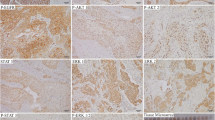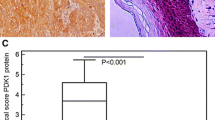Abstract
Objective
Inappropriate activation of JAK/STAT pathway occurs with high frequency in human cancers and is associated with cancer cell survival and proliferation. However, its role in oesophageal squamous cell carcinoma (ESCC) is unknown.
Methods
By immunohistochemistry, we analysed the expression of two components of this pathway, phosphorylated JAK-1 (pJAK-1) and phosphorylated STAT-3 (pSTAT-3), in 100 ESCC tumours and paired non-neoplastic oesophageal epithelia. Kaplan-Meier survival and Cox regression analyses were performed to evaluate the prognosis of patients.
Results
We found that pJAK-1 and pSTAT-3 expression was not detectable in normal oesophageal squamous cells. Primary ESCC with pJAK-1-positive and pSTAT-3-positive expression was detected in the cancer cell nests of 78 and 72 cases, respectively. In addition, the Pearson’s correlation coefficient between pJAK-1 and pSTAT-3 expression was 0.806 (p<0.001). Moreover, pJAK-1 and pSTAT-3 expression was correlated with N stage (lymph node metastasis, both p=0.01), pTNM stage (p=0.008 and 0.009, respectively) and metastatic status (both p=0.01). Furthermore, pJAK-1 and pSTAT-3 expression was associated with shorter overall survival (both p<0.001) and shorter disease-free survival (p=0.005 and 0.006, respectively). By multivariate analysis, TNM clinical classification (T, p<0.001; N, p=0.002; M, p=0.02), pJAK-1 (p=0.002) and pSTAT-3 (p=0.003) were independent prognosis predictors of ESCC.
Conclusion
These results provide convincing evidence for the first time that the JAK/STAT pathway may participate in the progress of ESCC.
Similar content being viewed by others
References
Jiang H, Gong M, Cui Y et al (2010) Upregulation of caspase-3 expression in esophageal cancer correlates with favorable prognosis: an immunohistochemical study from a high incidence area in northern China. Dis Esophagus 23:487–492
Wang WS, Zhong HJ, Xiao DW et al (2010) The expression of CFL1 and N-WASP in esophageal squamous cell carcinoma and its correlation with clinicopathological features. Dis Esophagus 23:512–521
Delektorskaya VV, Chemeris GY, Kononets PV et al (2009) Clinical significance of hyperexpression of epidermal growth factor receptors (EGFR and HER-2) in esophageal squamous cell carcinoma. Bull Exp Biol Med 148:241–245
Sano A, Sakurai S, Kato H et al (2009) Clinicopathological and immunohistochemical characteristics of esophageal carcinosarcoma. Anticancer Res 29:3375–3380
Kato H, Fukuchi M, Miyazaki T (2007) Surgical treatment for esophageal cancer. Current issues. Dig Surg 24:88–95
Bolli R, Dawn B, Xuan YT (2003) Role of the JAK-STAT pathway in protection against myocardial ischemia/reperfusion injury. Trends Cardiovasc Med 13:72–79
Booz GW, Day JN, Baker KM (2002) Interplay between the cardiac renin angiotensin system and JAK-STAT signaling: role in cardiac hypertrophy, ischemia/reperfusion dysfunction, and heart failure. J Mol Cell Cardiol 34:1443–1453
Gross ER, Hsu AK, Gross GJ (2006) The JAK/STAT pathway is essential for opioid-induced cardioprotection: JAK2 as a mediator of STAT-3, Akt, and GSK-3ß. Am J Physiol Heart Circ Physiol 291:827–834
Kandalam U, Clark MA (2010) Angiotensin II activates JAK2/STAT-3 pathway and induces interleukin-6 production in cultured rat brainstem astrocytes. Regul Pept 159:110–116
Darnell JE Jr (1997) STATs and gene regulation. Science 277:1630–1635
Levy DE, Darnell JE Jr (2002) Stats: transcriptional control and biological impact. Nat Rev Mol Cell Biol 3:651–662
Calo V, Migliavacca M, Bazan V (2003) STAT proteins: from normal control of cellular events to tumorigenesis. J Cell Physiol 197:157–168
Bromberg JF (2001) Activation of STAT proteins and growth control. Bioessays 23:161–169
Williams JG (2000) STAT signaling in cell proliferation and in development. Curr Opin Genet Dev 10:503–507
Valdembri D, Serini G, Vacca A (2002) In vivo activation of JAK2/STAT-3 pathway during angiogenesis induced by GM-CSF. FASEB J 16:225–227
Tu Y, Zhong Y, Fu J et al (2011) Activation of JAK/STAT signal pathway predicts poor prognosis of patients with gliomas. Med Oncol 28:15–23
Tam L, McGlynn LM, Traynor P et al (2007) Expression levels of the JAK/STAT pathway in the transition from hormone-sensitive to hormone-refractory prostate cancer. Br J Cancer 97:378–383
Hamilton S, Aaltonen L (2000) World Health Organization classification of tumors. Pathology and genetics of tumors of the digestive system. IARC, Lyon
Gao B, Shen XN, Kunos G (2001) Constitutive activation of JAK-STAT-3 signaling by BRCA1 in human prostate cancer cells. FEBS Lett 488:179–184
Song JI, Rubin Grandis J (2000) STAT signaling in head and neck cancer. Oncogene 19:2489–2495
Huang M, Page C, Reynolds RK (2000) Constitutive activation of stat 3 oncogene product in human ovarian carcinoma cells. Gynecol Oncol 79:67–73
Campbell CL, Jiang Z, Savarese DM (2001) Increased expression of the interleukin-11 receptor and evidence of Stat3 activation in prostate carcinoma. Am J Pathol 158:25–32
Berclaz G, Altermatt HJ, Rohrbach V (2001) EGFR dependent expression of Stat3 (but not STAT1) in breast cancer. Int J Oncol 19:1155–1160
Page C, Huang M, Jin X (2000) Elevated phosphorylation of AKT and Stat3 in prostate, breast, and cervical cancer cells. Int J Oncol 17:23–28
Wei L, Kuo ML, Chen CA (2003) Interleukin-6 promotes cervical tumor growth by VEGF-dependent angiogenesis via a STAT3 pathway. Oncogene 22:1517–1527
Turkson J (2004) STAT proteins as novel targets for cancer drug discovery. Exp Opin Ther Targets 5:409–422
Turkson J, Tammy Bowman T, Garcia R et al (1998) Stat3 activation by Src induces specific gene regulation and is required for cell transformation. Mol Cell Biol 18:2545–2552
Haura EB, Turkson J, Jove R (2005) Mechanisms of disease: insights into the emerging role of signal transducers and activators of transcription in cancer. Nat Clin Pract Oncol 2:315–324
Wang T, Niu G, Kortylewski M (2004) Regulation of the innate and adaptive immune responses by Stat-3 signaling in tumor cells. Nat Med 10:48–54
Niu G, Wright KL, Huang M (2002) Constitutive STAT3 activity up-regulates VEGF expression in tumor angiogenesis. Oncogene 21:2000–2008
Author information
Authors and Affiliations
Corresponding author
Rights and permissions
About this article
Cite this article
You, Z., Xu, D., Ji, J. et al. JAK/STAT signal pathway activation promotes progression and survival of human oesophageal squamous cell carcinoma. Clin Transl Oncol 14, 143–149 (2012). https://doi.org/10.1007/s12094-012-0774-6
Received:
Accepted:
Published:
Issue Date:
DOI: https://doi.org/10.1007/s12094-012-0774-6




